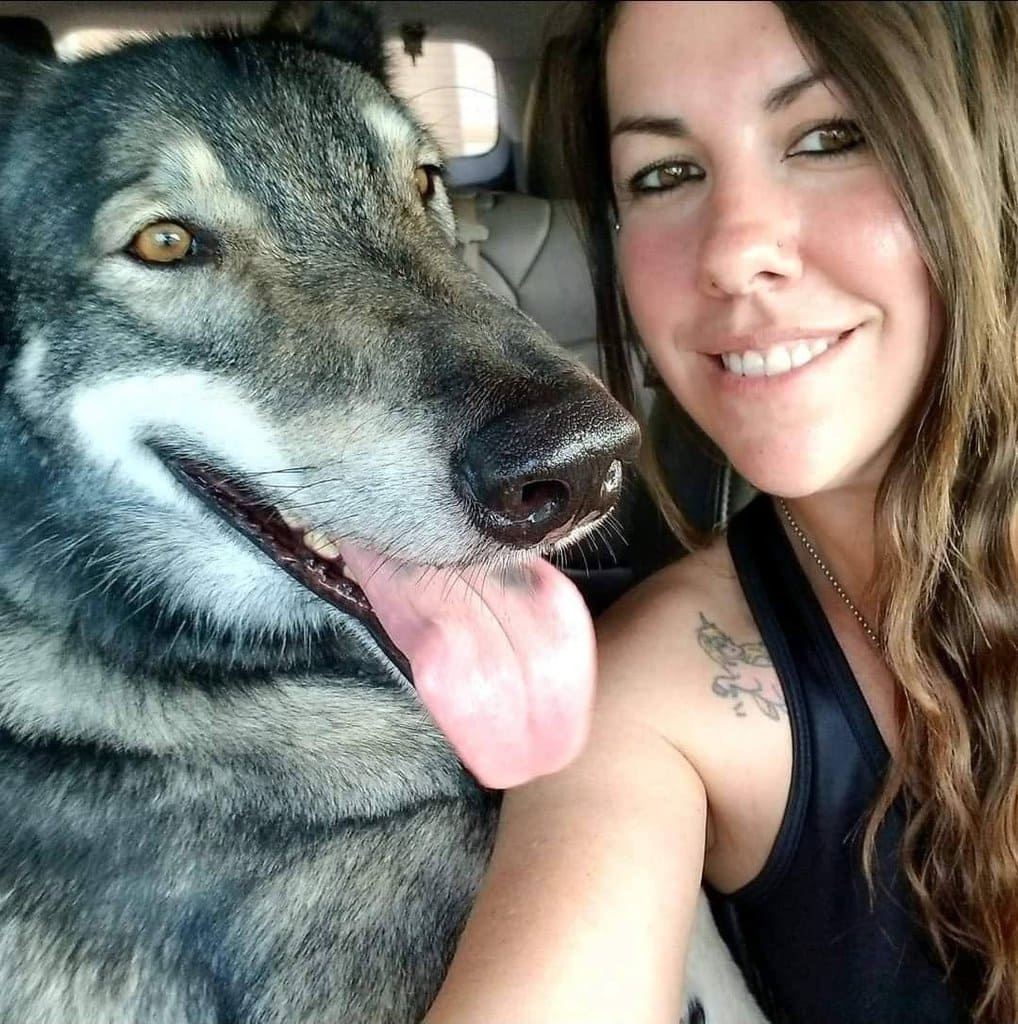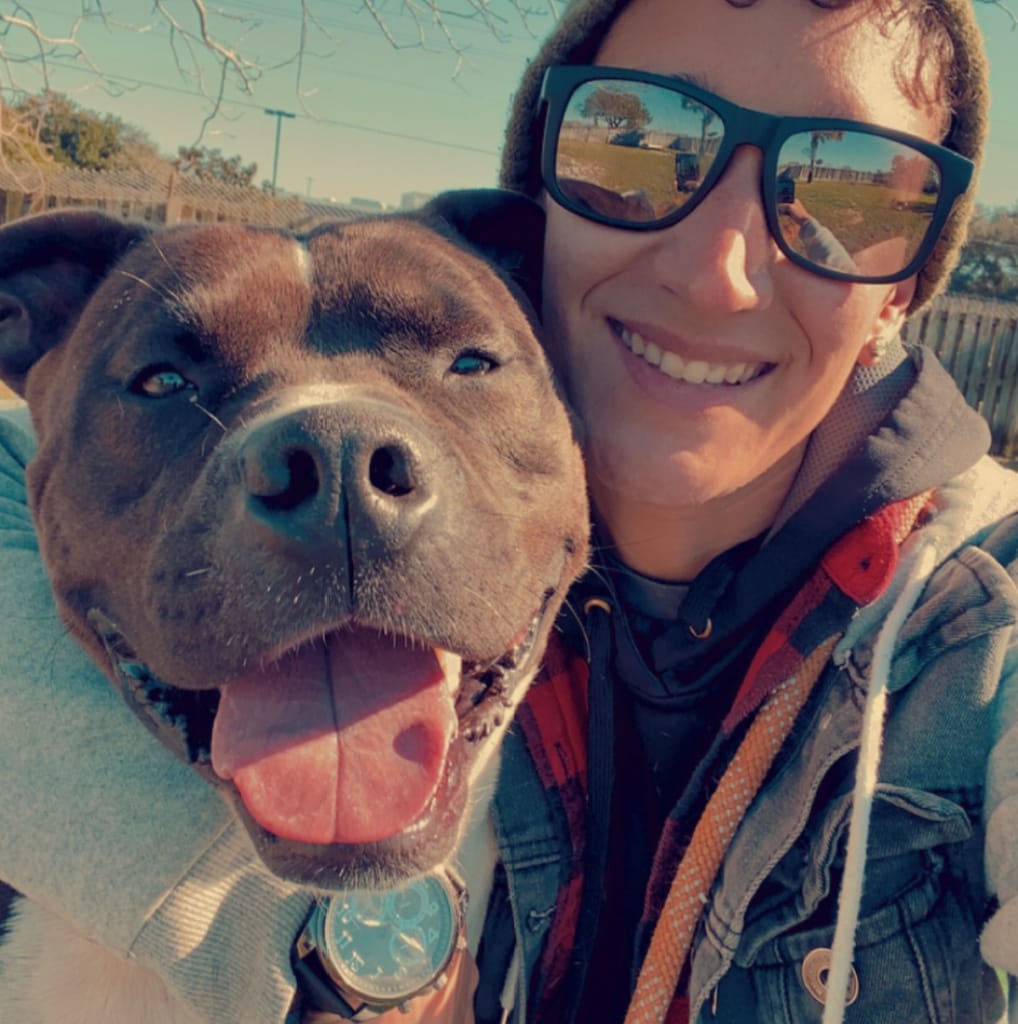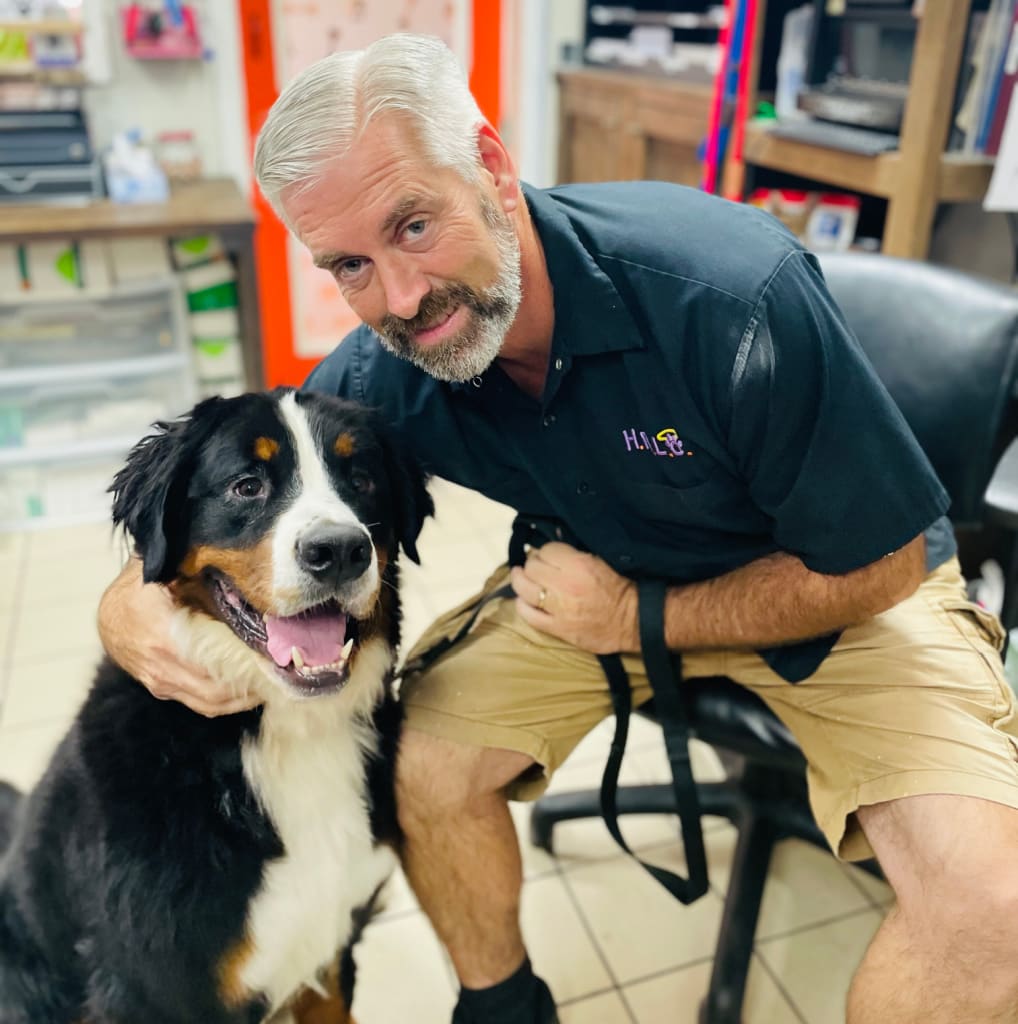Training Services
H.A.L.O.’s Training Center works with pet owners in crises to provide support and resources to keep pets in the homes that love them.
It’s your commitment that drives the no-kill movement and H.A.L.O. wants to support you, our community, every step of the way so that together we increase our lifesaving goals and further improve the relationships we each have with our pets!
FREE H.A.L.O. Alumni Training Sessions
At H.A.L.O., we are committed to helping our adopters integrate their new rescue pet into their family and help them become an important part of their lives. On occasion, a new pet needs help adjusting to their new home.
In this case, you can set up a 30-minute session with our training staff to work one-on-one to help with certain behaviors like leash pulling, jumping, being reactive towards other dogs and/or reactive towards people.
We can also help your dog become more social with other dogs by systematically introducing them to dogs at our shelter and create alternate practices to help mitigate problematic behaviors.
These sessions take place at our main adoption center located in Sebastian, Florida.
These sessions are at no charge and only available to H.A.L.O. Adoptees.
Ready to sign up?
1) Fill out our Training Registration Form. Upon completing the registration form, please use the calendar below to schedule your training session.
2) Print out our Training Session Waiver form and bring it with you to your training session.
Helpful Tips!
Socialize your puppy
Socializing your puppy is paramount for their development. Introduce them to various environments, people, and other animals in a positive and controlled manner. This exposure helps puppies adapt to different situations, reducing anxiety and fear as they grow.
Use a crate at home
Crate training comes in handy during everyday life. Some dogs might need a break from a bustling household or a familiar place to rest. Crates help dogs learn to self-soothe or deal with anxiety during situations where they become distressed, like during fireworks, thunderstorms, or construction. Dogs can retreat to their crates when situations are too chaotic or scary. Crate training also helps dogs confront new situations successfully, like the addition of a new baby or having company over. Crates keep curious puppies safely sequestered when you’re not able to supervise them. Dogs instinctively try to keep their sleeping areas clean. As such, the crate helps puppies learn to hold and strengthen their bladder and bowel muscles, making house breaking less of a chore for you and your dog. Positive reinforcement is the best way to introduce your dog to a crate. Try feeding breakfast, dinner, or snacks in the crate so it becomes a place of excitement.
Establish basic commands
Introduce basic commands such as sit, stay, lie down, and come. Consistency is key; use positive reinforcement techniques like treats and praise to reinforce good behavior. Short, frequent training sessions will help your puppy grasp these commands and build a foundation for further training.
Potty train your puppy
Implementing a consistent potty-training routine is crucial. Take your puppy out frequently, especially after naps, and playtime. Reward them when they relieve themselves in the designated spot to reinforce this behavior. If they don’t potty immediately, place them back in the crate for 20 minutes and try again. Continue this routine until they potty in the designated place and celebrate with positive reinforcements like treats, or freedom to romp around the house.
Get your puppy accustomed to grooming
Get your puppy accustomed to being handled and groomed early on. Gradually introduce brushing, nail trimming, and handling of their paws, ears, and mouth. This familiarity reduces stress during grooming sessions as they mature.
Teach bite inhibition
Puppies explore the world with their mouths, and teaching bite inhibition is essential. Encourage gentle play and discourage nipping or biting too hard by redirecting their attention to appropriate toys. If they continue to bite, try standing stiff until the puppy becomes bored. Usually, this will help redirect attention elsewhere.
Use positive reinforcement training techniques
As you probably noticed, we talk a lot about positive reinforcement and its benefits. When utilized, positive reinforcement, such as treats, praise and rewards, reinforces desired behaviors. Reward your dog immediately after they’ve performed the desired action, associating the behavior with a positive outcome. This method encourages good behavior and strengthens the bond between you and your pet.
Stay consistent
Consistency is vital for successful training. Maintain a regular schedule for sessions, keeping them short and focused to prevent your dog from getting bored or overwhelmed. Repetition and consistency reinforce the learning process, helping your dog grasp commands more effectively.
Use body language and hand signals strategically
Dogs communicate through body language. Learning to interpret your dog’s cues enhances communication and understanding. Additionally, incorporating hand signals alongside verbal commands aids in reinforcing these commands and allows for effective communication, particularly for dogs with hearing impairments.
Try clicker training
Clicker training, using a small handheld clicking device, marks the precise moment your dog performs a desired behavior, followed by a reward. The click serves as an instant marker , making it easier for your dog to understand the behavior that earned them the reward.
Maintain your dog’s attention and engagement
Maintaining your dog’s attention during training sessions is crucial. Employ high-value treats or rewards to keep their focus and motivation. Tailor your training to match your dog’s attention span, gradually increasing the difficulty level as they progress.
Identify and correct unwanted behaviors
Common behavior problems like excessive barking, chewing, jumping, or digging can be addressed through positive reinforcement. Redirect their attention to appropriate behaviors and reward them when they comply.
Be patient with attention span and distraction
Dogs, especially puppies, have short attention spans. Maintain focus during training sessions by keeping them short, engaging, and free from distractions. Gradually increase the duration as your dog’s attention span improves.
Establish house rules
Consistent rules and boundaries are vital. Ensure every family member understands and enforces these rules, promoting consistency in your dog’s behavior.
Address separation anxiety and fearful behavior
Dogs may exhibit separation anxiety or fear-related behaviors. Gradually desensitize them to triggers, introduce comforting routines, and create a safe space to alleviate their anxiety or fear. By addressing behavior problems with patience, consistency, and positive reinforcement, you’ll help your dog overcome challenges and foster positive behavioral changes, strengthening the bond between you and your dog.
Meet The Hooman Team!

Michelle Wallenstein
My name is Michelle Wallenstein and I’m the animal care manager at H.A.L.O. no-kill animal rescue.
My role at H.A.L.O. is to oversee any medical or behavioral issues concerning the animals under my care.
My aspirations at H.A.L.O. are to enrich the lives of these animals, both mentally and physically, until they find their forever homes.
Some interesting facts about me include; Zoo keeping for over 10 years and training numerous species such as, crocodilians, lemurs, anteaters and exotic birds!
I’ve also been doing outreach programs with exotic animals at schools, libraries and churches for 5 years, teaching children about conservation.
My training specialties include; leash walking skills, puppy training and unique tricks such as paddleboarding! I would love to work with your family to provide mental and physical stimulation to make your dog(s) successful and live a long happy life.

Nikki Cruz
Hi, my name is Nikki Cruz and I’m the Dog Behavioral Manager at H.A.L.O. No-Kill Animal Rescue! My position oversees the behavioral side of the dogs within the shelter to properly assure they are as comfortable as possible during their journey towards our shared goal of finding a family that fits their personality.
Fun fact! I was raised in a Military family and spent 26 years traveling around the world, meeting new people and adapting to all walks of life. With this experience, it’s allowed me to help teach animals, (humans too!) to adjust to the environment around them.
I specialize in Obedience, Leash-Walking, Socialization (which includes exploration, confidence building and social interactions between people and animals) as well as Puppy Training!
My goal is to help create a stable foundation for you to form a strong bond with your dog so you can grow and learn together.

Jeff Bolling
Hello, my name is Jeff Bolling, Director of Operations and head of training at H.A.L.O. No-Kill Rescue.
I started my professional training career in 1986 and have worked with many different types of animals at various zoological institutions.
During my tenure at zoos, I was fortunate to have the opportunity to focus on implementing and maintaining several elephant behavior training programs. These elephant training programs were built on the theory of positive reinforcement and allowed animal husbandry staff and veterinary staff to provide the elephants with the utmost quality of care.
As a Curator at Disney’s Animal Kingdom and the COO at the National Elephant Center, I was elected as a training instructor of the American Zoo and Aquarium Association for 10 years.
My start at H.A.L.O. began in 2014 when I got involved to help train a few behaviorally challenging dogs.
Since, I have shifted my focus to helping dog owners build a positive relationship built on leadership and trust.
I am confident that we can help improve your relationship and lead you both to success.
“Jeff is a God send. I adopted 2 larger dogs simultaneously a little over 8 yrs ago from HALO. After working with the two dogs a week prior to their homecoming, he then came to my house to socalize the dogs and teach me to handle them properly over a six week period. I encountered a behavioral issue last year which could have caused me to surrender my guy back to HALO and Jeff was able to immediately teach me how to handle it and we are all 3 living our best lives. I can’t say enough about Jeff’s abilities, compassion and understanding when it comes to pets and pet owners!!!!”
“I would just like to say a few things about Michelle Wallenstein and her training our dog Buster. Buster is a high energy Bull Terrier who was in need of discipline and obedience training. Michelle and Buster were and are the best of friends, he will do anything for her! Her knowledge, patience and caring are above and beyond. She has taught Buster how to station on a target, follow her commands off leash, how to play dead and a host of other tricks all while working on the basics as well. I highly recommend her for all doggie needs and Buster agrees!! Woof!!”
“I was fortunate to meet Nikki Cruz six years ago when my daughter adopted Harley from HALO. We started training when Harley was 12 weeks old with great success. Harley is a very well behaved, trained dog that we can take into any environment. Then we adopted Tiki, our yellow lab and immediately contacted Nikki 5 years ago to help us with our little nerve with fur and she is so well trained (thanks to Nikki) that she rarely uses a leash and is also well behaved and responds to commands with ease. Then here comes Teddy, my little 9-week-old Yorkie and boy was he Satan! I immediately contacted Nikki a year and a half ago for help as he was totally out of control. She immediately started training Teddy and myself and now 1 and 1/2 years later I have an unbelievably well-mannered dog that I get compliments on every time I take him out! I take Teddy everywhere… to stores, malls, parks, and friends’ homes. I recently took Teddy on his first vacation to Embassy Suites resort and he was amazing! He received multiple compliments on his trained behavior. I recommend Nikki to everyone I meet that needs a trainer. Her knowledge and compassion for dogs and their owners is absolutely amazing and shows in all three of our dogs.”
“I met Nikki back in 2018 right after I had adopted Harley (also formerly known as Munchkin) from H.A.L.O. No-Kill Rescue Shelter. Harley was just a baby when she met Nikki and I wanted the best possible guidance for Harley since she was so young. Nikki worked with Harley and I for years and throughout those years Harley has grown into the best well trained dog I’ve ever had the pleasure of owning. Harley walks incredibly well on her leash both in public and at home. She is social, willing, and brave due to Nikki’s incredible training and commitment to her. Nikki not only trained her but trained me to be the best handler I could be for her. Throughout the years I have watched Nikki work with dogs who didn’t have the foundation Harley was provided and instead found themselves with different hardships. Nikki took these dogs under her wing and made them into dogs that could find courage and strength within themselves. She eased their anxieties and gave them a foundation like my Harley has so they can grow and become the best companions. If you are looking for not just a trainer, but someone who will teach both you and your dog and build a relationship of trust and guidance between both of you, Nikki is the person for you. She is a genuine soul who when you meet her you can feel the love and passion she has for what she does. She is worth every minute, penny, and more. Thank you Nikki for making me into a better handler and for giving my Harley the foundation she needed to be such a great dog.”
“I would like to highly recommend Michelle Lee for any of your animal training needs. She is very experienced and has a very strong compassion for all God’s creatures. Within the past year, I had a need for her services. She trained my puppy on a weekly basis for a few months, and the behavioral change in him was impressive. She showed extreme patience with him and used a vast array of training techniques to get him to be a well behanved puppy. She cares about the animal’s physical, emotional and spiritual needs. I don’t hesitate to recommend her, she’s wonderful!”
Trainer Tips
Aggression in Dogs
Jeff Bolling- 2023
In this issue, we are going to cover the types of Aggression in dogs and what causes it.
The phrase I hear often is, “That dog is aggressive, it must have been abused.” In some cases that is true, but oftentimes it is not. Aggression is something that can be conditioned in a dog if they are successful with it. For example, if a dog sees a hand coming towards them and they bite the hand, then the hand goes away. The dog will make a mental note of that sequence of events and realize that when they use their teeth, the hand goes away, increasing the chances they will bite again if the hand comes back to them.
Let us look first at the types of aggression dogs exhibit. The most common is aggression towards prey, small animals like cats , squirrels and rabbits can be considered prey. Next, is aggression towards people and not too far behind that is aggression towards other dogs. Prey drive is an instinctual behavior that can be accentuated by breed.There can be several reasons a dog might be aggressive towards a person or a dog. Aggression can be caused by fear,hormones, genetics or something known as claiming. Fear is traditionally caused by under-exposure. If a dog is not socialized as a puppy with many different people, animals or situations, there is a high probability that they will be fearful and can react with aggression. Claiming is a very common problem with dogs. Claiming looks like protection to us and they can claim things like people, furniture, a home, a yard or even a neighborhood. Claiming is a problem because anything they don’t consider part of their pack or in their possession becomes something they feel they need to drive away.
Now let us look at behavior. Imagine behavior is simply a set of patterns in the brain which are formed by reinforcement. If a dog is allowed to perform a behavior that we do not desire, for a long period of time, those patterns of behavior become more prominent and are harder to untrain. It is important to identify problematic behaviors early in your dog. Then you can start the work or training that needs to be done to untrain what you do not want your dog to do and then retrain what you do want them to do. Doing so should take less time with this approach.
Training is just a game and there are rules for the game we play. It has been shown that Operant Conditioning using Positive reinforcement is the most effective way to train and that is the method used at H.A.L.O. Reinforcement like verbal praise, eye contact, touch and food rewards are all things we use at H.A.L.O. to increase a desired behavior.
We have a fantastic training team at H.A.L.O. and are eager to help our community with your training challenges.
